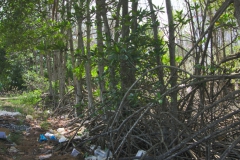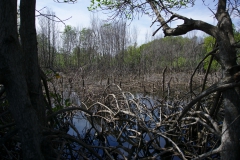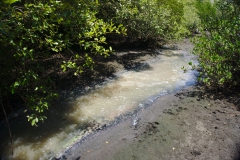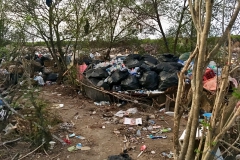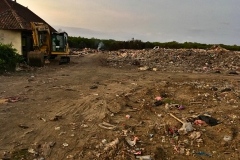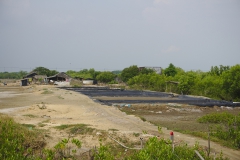Worldwide are mangrove forests exposed to anthropogenic influences. Land use changes, intensified timber industry and increasing water pollution are major threats. Today, mangroves cover an area of 137,000 km2 (Bunting et al., 2018). From 2000 to 2016 around 62% of global losses were attributed to land use changes – in particular to aquaculture and agriculture purposes (Goldberg et al., 2020). The expansion of palm oil plantations and mining in coastal areas are among new and rapidly increasing drivers of mangrove degradation (Worthington et al., 2020). However, current data sets give some hope: the destruction by humans has decreased (Goldberg et al., 2020), according to annual loss rates between 0.26% and 0.66% (Hamilton & Casey, 2016).
In particular, mangroves are cleared for industrial use – including the shrimp industry (Ocampo-Thomason, 2006; Berlanga-Robles et al., 2011; Hamilton, 2013; Hamilton & Lovette, 2015; Ghosh et al., 2015; Kauffman et al., 2017) as well as the industrial agriculture (Kauffmann et al., 2016), for rice fields or palm oil plantations (Richards & Friess, 2016). Since mangroves are located in scenic areas and easily accessible from the sea, they also have to give way to urbanization such as tourism, golf courses, harbors and industrial plants (Murray 2007; Hirales-Cota et al., 2010; Tuholske et al., 2017; Brenner et al., 2018).
An example is the coal power plant “Rampal”, which is being built just a few kilometers from the Sunderbans. The construction project has so far resulted in the displacement and land dispossession of thousands of people (Mahmud et al., 2020). Putting into operation would cause toxic substances and cooling water from the coal power plant and shipping traffic to enter the rivers, thereby threatening the ecosystem (Human Rights Watch; Im Sumpf der Sundarbans – Süddeutsche Zeitung). Bangladesh is one of the countries that have been hardest hit by the effects of climate change – a region that is already suffering from the effects of extreme weather events. The mangrove forest is not only an important bulwark against storm surges caused by tropical cyclones (like “Amphan”), but also the livelihood for more than 2 million people.
In many regions, nutrients and pesticides from agriculture and aquaculture, and other chemicals from waste water of rural communities, households and industries are entering rivers unfiltered, polluting the downstream located mangrove forests. Enriched effluents increase the risk for eutrophication (Barcellos et al., 2019). Chemicals and heavy metals contaminating sediments and soils (Anh et al., 2010; Satheeshkumar & Khan, 2011; Li et al., 2015)
Changes in hydrology, such as those resulting from dams, irrigation systems or other excessive water extraction, also endanger the mangroves due to the specific demands for water depth and tidal currents. Indirect consequences include dehydration and salinization of soil, coastal erosion and other effects leading to the loss of mangrove forests.
It is also expected that mangroves will react sensitive to sea-level rise, associated with climate change. In some locations, the mangroves may move into the hinterland, but this depends on the availability of suitable habitat and sediment load. Which enables them to maintain rates of soil-surface elevation that match or exceed that of sea-level rise. Sediment decline in some regions owes to anthropogenic activities such as damming of rivers (Lovelock et al., 2015; Lovelock et al., 2017). Many coasts suffer from the loss of biosphere due to urbanization.
Coastal erosion and extreme weather events also play a role in the destruction of mangrove forests. The slow and steady removal of sediment (erosion) causes the mangroves to lose their ground to root. Sea-level rise, heavy rainfall, high temperatures and increasing wave activity foster this process. Coastal erosion has destroyed large parts of the mangrove forests in Bangladesh (Sundarbans) and on the east coast of Brazil. In addition, due to climate change, extreme weather events (e.g. cyclones, heat waves, floods) are becoming more frequent and stronger, which the mangroves are less and less able to withstand (Goldberg et al., 2020). Oceania is one of the regions that is particularly hard hit.
wocomoTRAVEL (2008) Mangroven – Bedrohte Küstenwälder in Brasilien I Gärten der Meere, Teil 2
